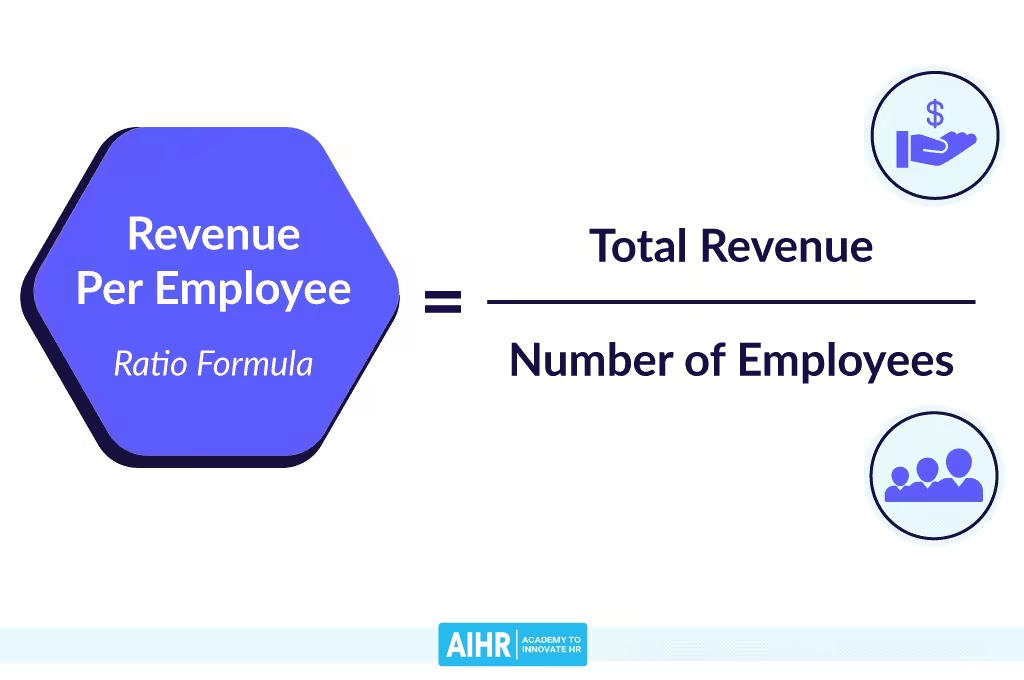What Is Revenue per Employee?
The ratio known as "revenue per employee" calculates an organization's total income by its current number of employees. It gives a ballpark figure for how much an organization makes per employee. It can be argued to be an essential ratio that generally gauges how much money each employee contributes to the company. It is computed by dividing a company's total revenue by the number of employees.
The revenue-per-employee ratio is helpful when examining historical changes in a company's ratio or comparing it to that of other businesses in the same industry as part of fundamental analysis. Revenue per employee aids in assessing the effectiveness and productivity of your staff.
Revenue per employee formula

The formula is often applied on an annual basis. Therefore, you would also use the number of employees in that calendar year and the total revenue the company made during that period. When extracting the data, you must select the correct period if you want to calculate it in other periods (such as quarterly or bi-annually).
How to calculate revenue per employee
Instance A
Megatronic Electronics do worldwide production of computer components. A brief study reveals that the company has 400 employees and a $500,000 annual revenue. As a result, the revenue per employee (RPE) is
Revenue per employee = $500, 000/ 400 is equal to $1,250 per employee
How Revenue per Employee Works
Because it indicates how effectively a given company uses its personnel, revenue per employee is an essential analytical tool. Profitable businesses frequently have high revenue-per-employee ratios. A corporation should aim for the best revenue per employee ratio feasible. A higher ratio denotes higher productivity. The development of productive employees indicates that a business is making use of its resources, in this case, its investment in human capital.
Some analysts use a variant of the revenue-per-employee ratio. They substitute revenue with net income. Sales per employee is a ratio similar to revenue per employee, and it can be calculated by dividing annual sales by the total number of employees.
Factors Influencing the Revenue per Employee Ratio
Industry of the Business
A company's revenue per employee should be compared to that of other businesses in its industry, particularly its immediate competitors because labor demand differs by industry. In isolation, this ratio is not very useful.
For instance, traditional banking needs numerous staff members to staff brick-and-mortar branches and assist customers. In contrast, internet banks don't need to staff physical premises with workers because they conduct business online. As a result, a banker would want to assess how its company's revenue per employee ratio compares to that of other financial institutions of a similar nature. The revenue-per-employee ratios of businesses in labor-intensive sectors like agriculture and hospitality are often lower than those in other industries.
Employee Turnover
Employee turnover is the percentage of the total staff that departs voluntarily (or is dismissed) each year and needs to be replaced. It has an impact on a company's revenue per employee.
A corporation often has to interview, hire, and train new employees due to employee turnover.
The Age of the Company
Startup businesses may still have modest revenues even though hiring to fill essential positions. These businesses typically have lower revenue-per-employee ratios than seasoned businesses that can hire for the same critical positions over a broader revenue base.
Why It's Important to Track Revenue per Employee
Revenue per employee figures is utilized historically to make strategic planning decisions. It may be assumed that your team is operating more effectively if your revenue per employee rises over time while the total workforce remains constant. If your revenue per employee is declining, you may have too many employees, diluting their value. Or perhaps you have employees who are not being utilized properly. A crucial component of your company's overall financial stability is the revenue per employee.
Which Revenue Per Employee Is the Best?
There is no magic solution because income per employee depends entirely on the industry. There is no universal benchmark for a decent revenue per employee value across all industries. Also, remember that this value will vary depending on the size and age of your company. According to Klipfolio, a suitable benchmark for revenue per employee varies from $43,000 for businesses with less than $1 million in annual revenue to $230,000 for those with $50 million or more.
It's crucial to keep in mind that revenue per employee is not very meaningful without context.
What if your Revenue Per Employee Is Low?
Consider these queries if your income per employee is low:
- Is a higher revenue per employee necessary?
- How do you compare against the competitors in your field?
- When was your company founded?
- Are you experiencing rapid expansion and hiring?
- What is your profit per employee and profit margin?
Increasing Revenue per Employee: Strategies
Increasing revenue or reducing employees are the two options to improve revenue per employee.
A leaner staff can be achieved by automating duties. You must plan measures to increase your revenue if you want to keep your personnel.
To guarantee that everyone is in a role most suited to their talents and abilities, start by evaluating your current staff. Lower production might frequently result from misaligned talent.
Let's face it: layoffs and The Great Resignation caused by the pandemic have resulted in a reduced workforce. Even with a lower crew, the output is still tremendously strong. Technology integration enables businesses to expand without cutting staff.
Why does HR need to calculate revenue per employee?
By monitoring this measure, human resources workers can learn helpful information.
- Obtaining a general understanding of how your team is performing-. As a result, you can use several HR initiatives to increase employee productivity, including burnout management and workload and stress monitoring.
- Finding areas in need of improvement- You can see where you fall short, especially when you compare your results to industry data. Additionally, you can monitor your rivals to see what HR strategies they are using to inspire their staff. For instance, some sales teams have a fixed compensation structure, while others have an incentive-based system for every X dollar in sales. You can evaluate which compensation plan will excite staff members and provide higher income for each worker.
- Being aware of how many workers you'll require- How many more employees are required to raise income by X%? On the other hand, can you maintain the same revenue with fewer employees? As financial goals are closely linked to HR activities at the beginning of the year, this also offers HR a seat at the table for decision-making.
- Beyond seeing employees as an expense – Employees are typically listed as an expense on the financial statements. On the other hand, revenue per employee tells a contrasting tale of how to view human capital, investments in workers, and returns.
Conclusion
While revenue per employee is an important indicator, it should be used in conjunction with other metrics and subjected to comparisons to obtain a more precise picture of the effectiveness and success of your company.

